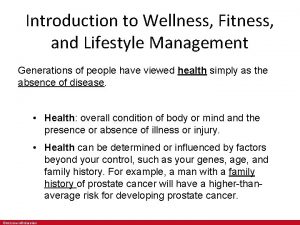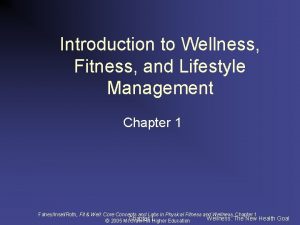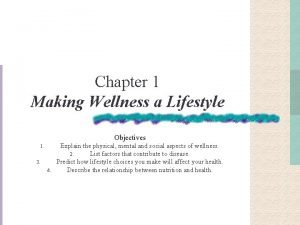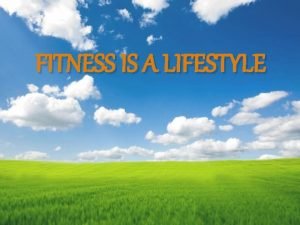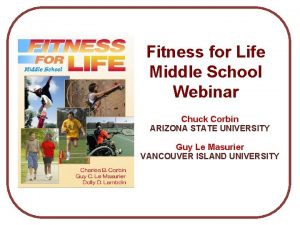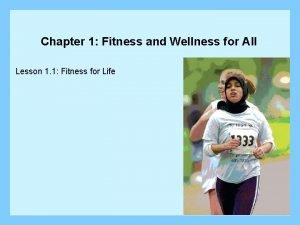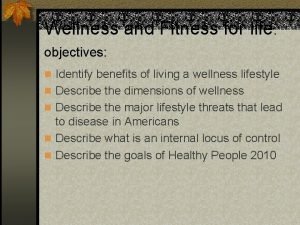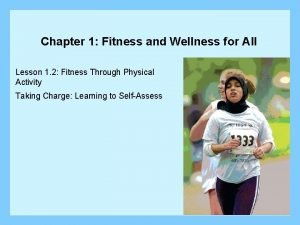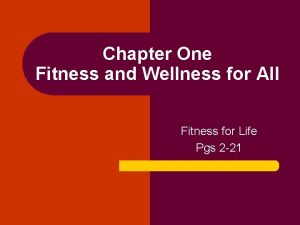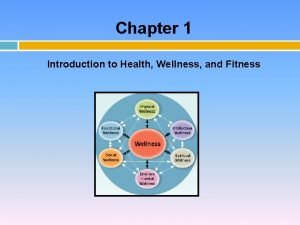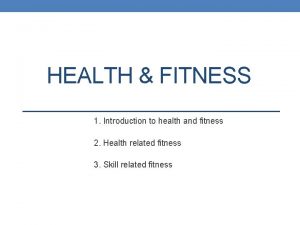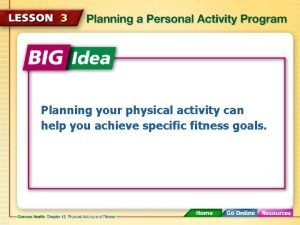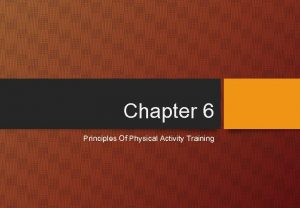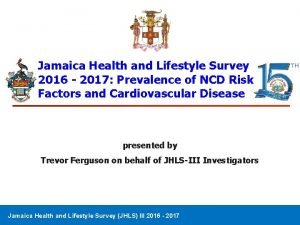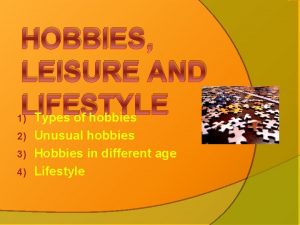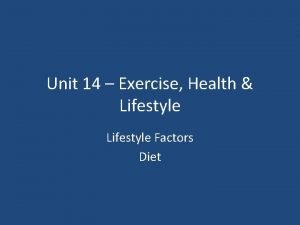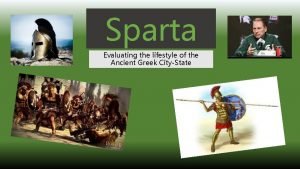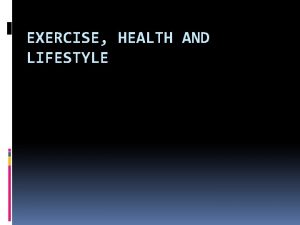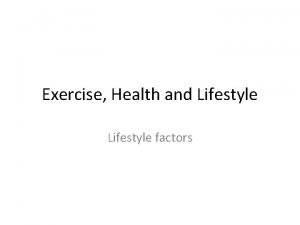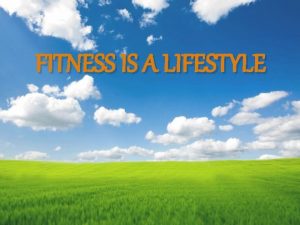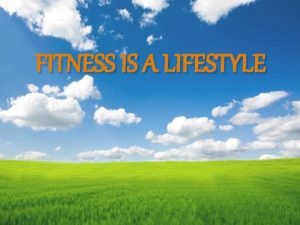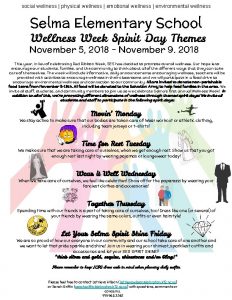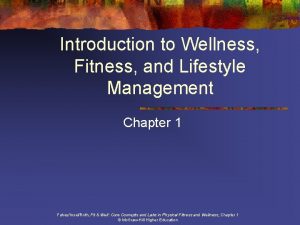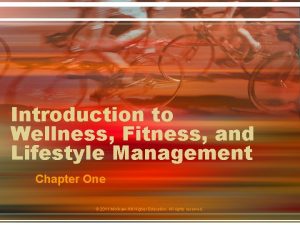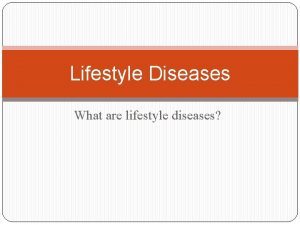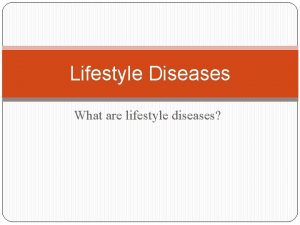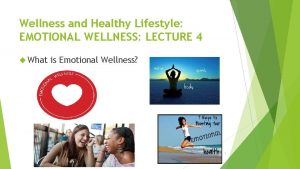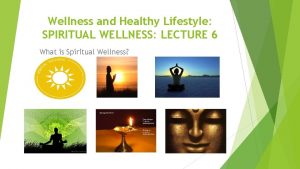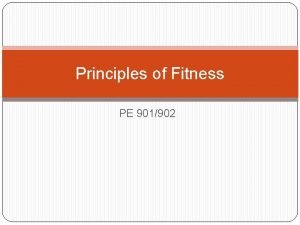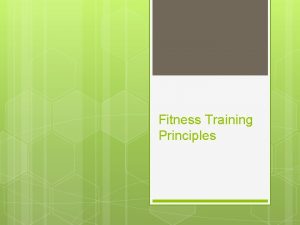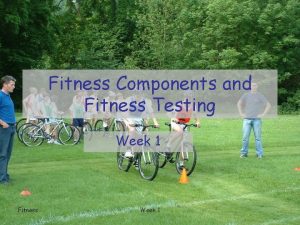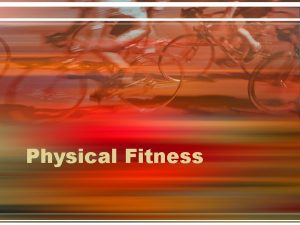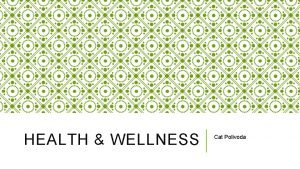Introduction to Wellness Fitness and Lifestyle Management Principles



























- Slides: 27

Introduction to Wellness, Fitness, and Lifestyle Management & Principles of Physical Fitness Quiz II Wellness Weight Training Fall 2012 © Mc. Graw-Hill Higher Education. All Rights Reserved

Wellness: The New Health Goal Health refers to the overall condition of a person’s body or mind and to the presence or absence of illness or injury. Health differs based on factors beyond your control, such as genes, age, and family history Wellness refers to optimal health and vitality. Wellness is determined by the decisions you make about the way you live. Experts have determined 6 Dimensions of Wellness: Physical wellness Emotional wellness Intellectual wellness Spiritual wellness Interpersonal wellness Environmental wellness Plus- Occupational and Financial wellness © Mc. Graw-Hill Higher Education. All Rights Reserved

Behaviors That Contribute to Wellness Be physically active Choose a healthy diet Maintain a healthy body weight Daily lifestyle choices Get the proper amount of sleep Manage stress effectively Avoid tobacco and drug use and limit alcohol consumption Protect yourself from disease and injury © Mc. Graw-Hill Higher Education. All Rights Reserved

Leading Causes of Death in the United States 1. Heart disease: 599, 413 2. Cancer: 567, 628 3. Chronic lower respiratory diseases: 137, 353 4. Stroke (cerebrovascular diseases): 128, 842 5. Accidents (unintentional injuries): 118, 021 6. Alzheimer's disease: 79, 003 7. Diabetes: 68, 705 8. Influenza and Pneumonia: 53, 692 9. Kidney problems: 48, 935 10. Intentional self-harm (suicide): 36, 909 © Mc. Graw-Hill Higher Education. All Rights Reserved

What is Physical Activity? Physical activity is any body movement carried out by the skeletal muscles and requiring energy Exercise refers to a subset of physical activity: a planned, structured, repetitive movement of the body designed to improve or maintain physical fitness. Levels of fitness depend on the following: Heart’s ability to pump blood Size of muscle fibers Genetics and the person’s mindset © Mc. Graw-Hill Higher Education. All Rights Reserved

Components of Health-related Fitness There are 5 areas of fitness which help establish health benefits Health-related fitness helps you withstand physical challenges and protects you from diseases The 5 components are: Cardiorespiratory Fitness Muscular Strength Muscular Endurance Flexibility Body Composition © Mc. Graw-Hill Higher Education. All Rights Reserved

Cardiorespiratory Fitness Ability to perform prolonged, large muscle, dynamic exercise at moderate to high levels of intensity Benefits include: Improved extraction of oxygen from blood to muscles Improved cardiac functioning Decreased resting heart rate and blood pressure You can develop cardiorespiratory endurance through the following activities: Walking Jogging Cycling Aerobic dancing Activities should be continuous, rhythmic, including large muscle groups, such as the legs © Mc. Graw-Hill Higher Education. All Rights Reserved

Cardio Exercises © Mc. Graw-Hill Higher Education. All Rights Reserved

Muscle Strength and Endurance Muscular Strength is the capacity of the muscle to exert force with a single maximum effort Muscular Endurance is the capacity of the muscle to exert force repeatedly over a period of time, while resisting fatigue Benefits include: Increased body mass Increased bone density Improved metabolism Improved posture and reduction of low back pain Being able to perform your daily routines with greater ease, allows you to look and feel better, as well as manage stress © Mc. Graw-Hill Higher Education. All Rights Reserved

Muscular Strength Muscular Endurance © Mc. Graw-Hill Higher Education. All Rights Reserved

Flexibility Ability of joints to move through the full range of motion Flexibility is needed in everyday routines Benefits include: Lowers the risk of back injuries Maintains posture and lowers the risk of other joint injuries Reduces stiffness as one ages Flexibility is affected by many factors such as joint structure, length and elasticity of connective tissue, age, gender, and nervous system activity © Mc. Graw-Hill Higher Education. All Rights Reserved

Flexibility © Mc. Graw-Hill Higher Education. All Rights Reserved

Body Composition The proportion of fat and fat-free mass (muscle, bone, water) in the body The relative amount of body fat a person has does have an impact upon overall health and fitness Too much body fat could have the following effects: Heart disease Obesity Diabetes Different forms of cancer Back pain By becoming more physically active, the reduction of body fat can be achieved, resulting in health improvement. © Mc. Graw-Hill Higher Education. All Rights Reserved

Body Composition © Mc. Graw-Hill Higher Education. All Rights Reserved

Reversibility-Adapting to a Reduction in Training Fitness is a “reversible” adaptation If you stop exercising, up to 50% of most fitness improvements are lost within 2 months Strength fitness can be maintained as infrequently as once a week compared to cardiovascular or cellular fitness levels It is NEVER too late to start exercising © Mc. Graw-Hill Higher Education. All Rights Reserved

Specificity-Adapting to Type of Training To develop a particular fitness or skill component, you must perform exercises specifically designed for that activity Weight training will develop muscular strength but will not be very effective to improve cardiorespiratory endurance or flexibility Each person responds to training at different rates A well-rounded exercise program includes all components of fitness designed to improve different parts of the body or towards specific sport activities © Mc. Graw-Hill Higher Education. All Rights Reserved

Lifting weights The genealogy of lifting can be traced back to the beginning of recorded history where man's fascination with physical abilities can be found among numerous ancient writings. Progressive resistance training dates back at least to Ancient Greece, when legend has it that wrestler Milo of Croton trained by carrying a newborn calf on his back every day until it was fully grown. Another Greek, the physician Galen, described strength training exercises using the halteres (an early form of dumbbell) in the 2 nd century. © Mc. Graw-Hill Higher Education. All Rights Reserved

Bar Grips © Mc. Graw-Hill Higher Education. All Rights Reserved

Grip Widths © Mc. Graw-Hill Higher Education. All Rights Reserved

Positioning Exercises performed while standing typically require feet to be positioned slightly wider than hip-width, with the heels and balls of the feet in contact with the floor. Seated or supine exercises performed on a bench usually require a five-point body contact position. © Mc. Graw-Hill Higher Education. All Rights Reserved

Core and assistance exercises - Core exercises recruit one or more large muscle areas, involve two or more primary joints, and receive priority when selecting exercise because of the direct application to the sport. - Assistance exercises usually recruit smaller muscle areas, involve only one primary joint, and are considered less important to improving sport performance. © Mc. Graw-Hill Higher Education. All Rights Reserved

Structural and power exercises - A structural exercise (single joint) involves muscular stabilization of posture while performing the lifting movement. - A power exercise (multi joint) is a structural exercise that is performed very quickly or explosively. © Mc. Graw-Hill Higher Education. All Rights Reserved

Movement Analysis of the Sport-specific exercise: The more similar the training activity is to the actual sport movement, the greater the likelihood that there will be a positive transfer to that sport. Muscle balance: Exercises selected for the specific demands of the sport should maintain a balance of muscular strength across joints and between opposing muscle groups. © Mc. Graw-Hill Higher Education. All Rights Reserved

Other Factors in Exercise Selection Exercise technique experience: The athlete should be able to perform the exercise with proper technique. Availability of resistance training equipment: A lack of certain equipment may necessitate selecting exercises that are not as sport specific. More highly resistance-trained athletes can augment their training by using a split routine in which different muscle groups are trained on different days. © Mc. Graw-Hill Higher Education. All Rights Reserved

Factors in Training Frequency Sport season: Practicing the sport skill during the in-season necessitates a decrease in the time spent in the weight room. Training load and exercise type: Athletes who train with maximum or near-maximum loads require more recovery time prior to the next training session. Other training: If the athlete’s program already includes aerobic or anaerobic training, sport skill practice, or any combination of these components, the frequency of resistance training may need to be reduced. © Mc. Graw-Hill Higher Education. All Rights Reserved

Four Methods of Ordering Exercises Power, other core, then assistance exercises -Multi-joint exercises and then single-joint exercises or large muscle areas and then small muscle areas -Preexhaustion (fatiguing a large muscle group as a result of a single-joint exercise being performed prior to a multi-joint exercise that involves the same muscle) Upper- and lower-body exercises (alternated) “Push” and “pull” exercises (alternated) Supersets (two exercises that stress two opposing muscles or muscle areas) Compound sets (sequentially performing two different exercises for the same muscle group) © Mc. Graw-Hill Higher Education. All Rights Reserved

Upcoming Thursday October 25 we will have Quiz II in this room. No working out that day. See you on Thursday! © Mc. Graw-Hill Higher Education. All Rights Reserved
 Introduction to wellness fitness and lifestyle management
Introduction to wellness fitness and lifestyle management Wellness and lifestyle management
Wellness and lifestyle management Making wellness a lifestyle
Making wellness a lifestyle Www.youtube
Www.youtube Stairway to lifetime fitness health and wellness
Stairway to lifetime fitness health and wellness Fitness ch 1
Fitness ch 1 Objectives of fitness and wellness
Objectives of fitness and wellness Stairway to lifetime fitness health and wellness
Stairway to lifetime fitness health and wellness Fitness chapter 1
Fitness chapter 1 Wells fargo wellness program
Wells fargo wellness program Skill related fitness vs health related fitness
Skill related fitness vs health related fitness Fitness vs wellness
Fitness vs wellness Introduction of health and fitness
Introduction of health and fitness Ability to use voluntary muscles repeatedly without tiring
Ability to use voluntary muscles repeatedly without tiring An exercise session has three stages
An exercise session has three stages 6 principles of training
6 principles of training Modern lifestyle and hypokinetic diseases
Modern lifestyle and hypokinetic diseases Jamaica health and lifestyle survey 2019
Jamaica health and lifestyle survey 2019 Lifestyle and hobbies
Lifestyle and hobbies Fashion and lifestyle logistics
Fashion and lifestyle logistics Self concept and lifestyle
Self concept and lifestyle Unit 14 exercise health and lifestyle
Unit 14 exercise health and lifestyle Lifestyle of sparta
Lifestyle of sparta Exercise health and lifestyle
Exercise health and lifestyle Exercise health and lifestyle
Exercise health and lifestyle Leisure time hobby
Leisure time hobby Centralization by henri fayol
Centralization by henri fayol Basic principles of cost management in project management
Basic principles of cost management in project management
